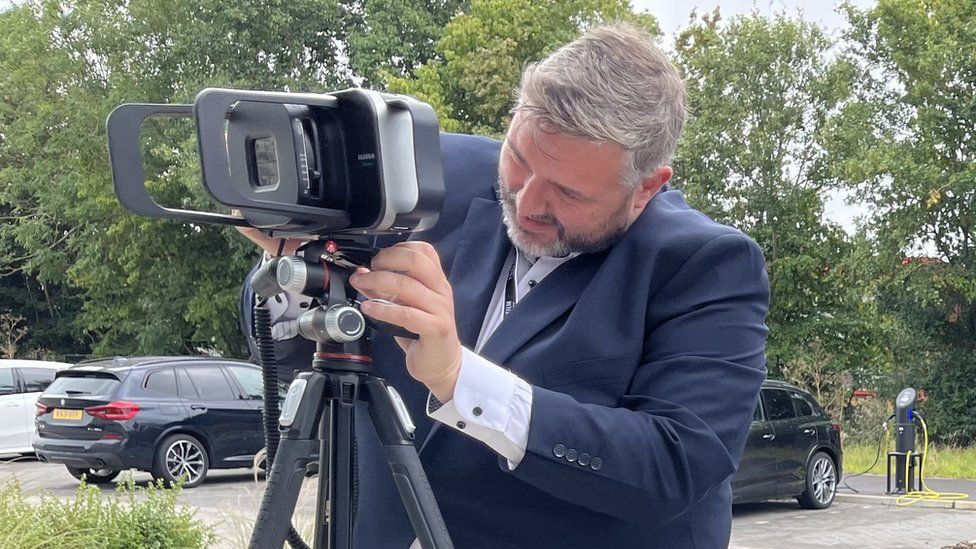ARTICLE AD BOX
 Image source, Christine Ro
Image source, Christine Ro
Portable X-ray machines, such as this one pictured, are seeing a big rise in use
By Christine Ro
Technology reporter
Portable X-ray machines "can literally be the difference between life and death", says radiographer Sam Pilkington.
For most of us, if we need to be X-rayed the procedure is done in a hospital. But for acutely unwell patients, or for infection control, Ms Pilkington says that portable machines are very helpful.
This is because "they remove the excess burden of transportation from the patients", says the final-year student at the University of the West of England in Bristol, who is also a member of the Institute of Physics. Instead the X-ray equipment goes to them.
There are obvious advantages for remote locations, including battlefields, roadsides and disaster zones.
And thanks to the increased availability - and ability - of such portable systems their usage is growing rapidly. With the coronavirus pandemic fuelling this increase, the global portable X-ray market was worth a reported $7.1bn (£5.6bn) last year. And this is expected to rise to $14bn by 2028.
In simple terms there are two types of portable X-ray machines - those on wheels, which are generally described as "mobile", and the lightest devices that can be carried by a single person. These are generally described as "ultraportable".
Image source, IDDS/Stop TB Partnership
Image caption,Portable X-ray machines are now said to produce images of similar standard to big, fixed devices in hospitals
One remote place that has tested ultraportable X-ray hardware is the Orkney Islands in Scotland. Prior to a trial there from November 2021 to January 2022, 73% of patients who were due for an X-ray did not attend their appointments - due in large part to the costs and time needed to reach distant hospitals.
During the trial, a handheld device made by Japanese firm Fujifilm was taken to local clinics. Called the Fujifilm Xair, it weighs just 3.5kg, and is only 301mm (12 inches) wide and 144mm tall.
As a result of its use, the non-attendance rate for X-rays appointments was reduced to zero.
As one patient commented to the subsequent report: "This is hugely beneficial to people on the small islands. Much less upheaval for frailer patients."
German company OR Technology is another manufacturer of portable X-ray machines. Tim Thrun, its chief commercial officer, says it is seeing great interest from emerging markets. "There's a huge demand for bringing healthcare to the people," he says.
Image source, OR Technology
Image caption,This mock-up shows how a portable X-ray machine could take pictures at accident scenes
In the Philippines, Nigeria and other countries in the developing world, portable X-ray systems are transforming screening for tuberculosis (TB), which kills approximately 1.3 million people a year despite being preventable and curable.
It's long been known that a chest X-ray is the best screening tool for TB, explains Suvanand Sahu, the deputy executive director of the Stop TB Partnership. This Swiss-based organisation represents more than 1,500 government and non-government bodies around the world.
But he says that access to X-rays was historically hampered by a lack of hospitals. This was particularly the case in remote areas, and among remote, nomadic and displaced groups.
Dr Sahu says that portable X-ray machines, which often include artificial intelligence software to quickly process the images, have been a powerful solution that allows detection to be successfully done out in the field.
"About 10 years ago, if we would have said 'we can we do an X-ray in the community, with the computer reading it', I think people would have jumped out of their seats. But it has happened now."
Dr Sahu adds that the AI has enabled a "quantum leap" in how accurately and quickly these X-rays can be read.
Image source, IDDS/Stop TB Partnership
Image caption,Portable X-ray machines are now being used in countries such as the Philippines to test for TB
Yet some are worried about the radiation released by portable X-ray machines. Portable X-ray equipment works in the same way as the big, fixed machines in radiology departments in hospitals - the image is created by a targeted burst of ionizing radiation.
In hospitals, x-ray rooms are carefully designed to minimise radiation exposure, for instance with lead walls.
Mr Thurn says that with portable systems this lack of shielding is compensated for by the greater space where they are used, be it outdoors, or in a field hospital setup. In these cases he says that healthcare workers can stand much further away.
However, the issue of radiation needs to be clarified, as currently the international guidelines on radiation safety "are designed for the traditional fixed type of X-ray", says Zhi Zhen Qin, a digital health specialist at the Stop TB Partnership.
The image quality of portable X-ray machines used to be a concern as well. But Miss Pilkington says that today's machines rival fixed units in this regard: "The images that are taken on those machines are of a comparable diagnostic standard."
New Tech Economy is a series exploring how technological innovation is set to shape the new emerging economic landscape.
However, there are barriers to just how small the components of an X-ray system can get. If an X-ray detector is too small to capture a body part in a single exposure, extra images might need to be taken, which would add to time burdens and radiation doses.
And units with a limited battery life or data storage, reduce how many patients can be imaged in one session.
Meanwhile, some systems described as portable aren't exactly lightweight and easily transported, particularly if they need other hardware to make them work like a stand or computer equipment.
Yet Australian firm Micro-X is now making much lighter ultraportable x-ray machines, due to its new technology that can produce the X-rays without creating heat. This does away with the need for oil and motors for cooling, which add weight.
The high cost of portable X-ray machines is also an issue. While they are cheaper than the larger fixed machines, they are still very expensive.
The Stop TB Partnership says that the price of ultraportable machines ranges between $47,000 and $66,000. There are additional costs for warranties, installation and software.
Dr Suvanand says that as more manufacturers enter this space, "we hope that the competition will drive down the prices".
Ultimately, his vision for the future is that "everybody who needs an X-ray should have access to this type of modern, digital, ultra-portable X-ray with AI capability".

 1 year ago
48
1 year ago
48








 English (US) ·
English (US) ·